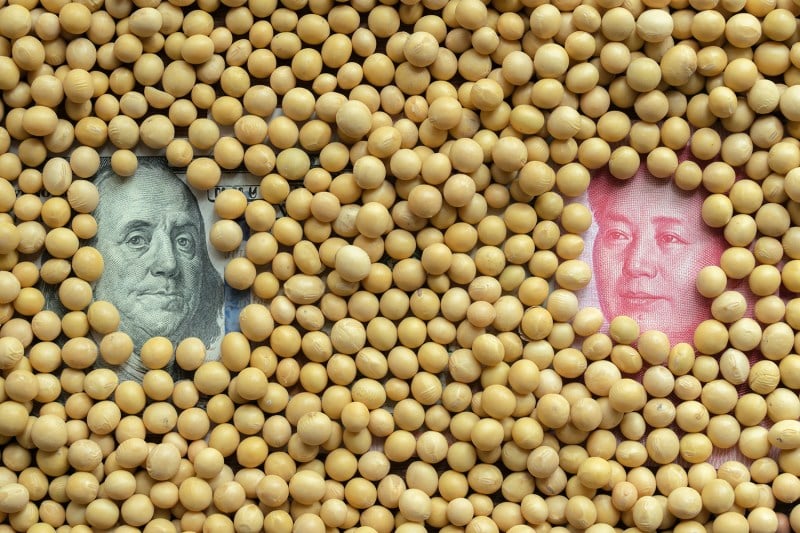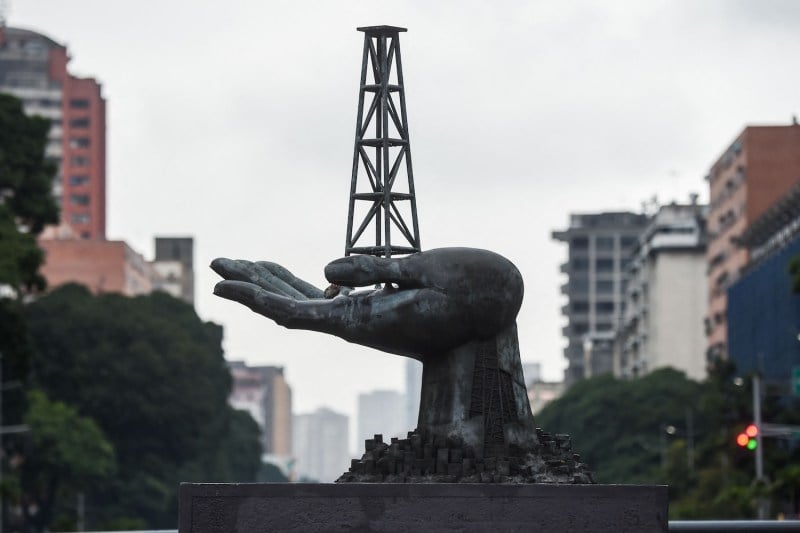China Fires Back at U.S. in Escalating Trade War

China Fires Back at U.S. in Escalating Trade War
Beijing matches Trump’s 34 percent tariff and imposes other measures.
Zhang Peng/LightRocket via Getty Images photo illustration
China is the first major country to strike back at the United States with counter-tariffs in response to the global trade war that U.S. President Donald Trump launched this week. The Chinese Ministry of Finance announced on April 4 that Beijing will levy 34 percent tariffs on all U.S. imports, on top of existing tariffs. The new measures will go into effect on April 10, a day after Trump’s “retaliatory tariffs” on China and other U.S. trading partners are scheduled to begin.
China’s announcement matches the U.S. move, eye for eye. On April 2, Trump’s so-called “liberation day,” the United States slapped 34 percent tariffs on Chinese goods, on top of the 20 percent duties already imposed over the past two months and preexisting tariffs. In total, the back-to-back hits will bring the average tariff rate on Chinese imports up to 76 percent, according to Chad Bown, an international trade expert at the Peterson Institute for International Economics. That number goes beyond the 60 percent tariffs that Trump threatened to impose on China during his election campaign.
China is the first major country to strike back at the United States with counter-tariffs in response to the global trade war that U.S. President Donald Trump launched this week. The Chinese Ministry of Finance announced on April 4 that Beijing will levy 34 percent tariffs on all U.S. imports, on top of existing tariffs. The new measures will go into effect on April 10, a day after Trump’s “retaliatory tariffs” on China and other U.S. trading partners are scheduled to begin.
China’s announcement matches the U.S. move, eye for eye. On April 2, Trump’s so-called “liberation day,” the United States slapped 34 percent tariffs on Chinese goods, on top of the 20 percent duties already imposed over the past two months and preexisting tariffs. In total, the back-to-back hits will bring the average tariff rate on Chinese imports up to 76 percent, according to Chad Bown, an international trade expert at the Peterson Institute for International Economics. That number goes beyond the 60 percent tariffs that Trump threatened to impose on China during his election campaign.
China exports nearly $440 billion in goods to the United States, from iPhones to toys. Trump’s tariffs on those imports are expected to be a drag on U.S. GDP and increase inflation. At the same time, the tariffs will likely deal a blow to the Chinese economy, shaving some 2.4 percent off its GDP this year, according to one projection from Citigroup.
China had taken a measured approach to Trump’s tariffs until this week. But faced with real economic pain, the country decided to swing harder at the United States. Although Beijing’s tariff rate matches Trump’s, the U.S. tariffs include carve-outs for energy and chips, among other products. Beijing provides no such loopholes, making its tariffs more aggressive by some measures. “These new measures can be viewed by the White House as non-proportional and risk a further response from the White House in terms of additional retaliatory steps, including tariffs,” said Wendy Cutler, vice president at the Asia Society Policy Institute.
At the same time, China imports far less from the United States than it exports to the country—$143.5 billion. That means China has less leverage when it comes to trade. Still, the new tariffs will put the squeeze on some U.S. industries.
U.S. farmers will be hit particularly hard. China imported more than $29 billion in agricultural goods from the United States in 2024, with its biggest purchases being soybeans, oilseeds, and grains. Last month, China imposed 10 to 15 percent tariffs on key U.S. agricultural products, and the new 34 percent will be layered on top. One trader told Reuters, “It is like shutting down all U.S. agricultural imports. We are not sure if any imports will be viable with 34 percent duty.”
Angry U.S. farmers in Republican-majority states, facing tariffs from China and likely other countries soon, will be hard for Trump to ignore. “I think this is definitely at the high end of escalation, I would say, so I don’t think it’s going to sit very comfortably in the White House at all,” said George Magnus, an economist at Oxford University’s China Center.
Rising prices on U.S. imports will also affect China, of course, but experts said China can still substitute U.S. goods with those from other countries. Brazil is likely to emerge as a winner in the U.S.-China trade war, for instance, as China looks for a new source of soybeans. The country already benefited from new Chinese demand as a result of Trump’s trade war with China during his first term.
Beyond the tariffs, China imposed other retaliatory measures on April 4. They include adding 11 U.S. companies to China’s unreliable entities list, meaning the firms cannot do business in China; adding 16 U.S. companies to China’s export control list, banning Chinese companies from exporting dual-use items to those firms; launching an anti-dumping investigation into a CT X-ray tube maker and an anti-monopoly investigation against U.S. chemical firm Dupont; and blocking certain U.S. sorghum and poultry companies from exporting to China on the basis of food safety concerns.
Of particular note is Beijing’s announcement of export restrictions on seven kinds of heavy rare earth elements, the powerful raw materials that underpin advanced weapons systems and green technologies.
By targeting rare earths, Beijing is highlighting one of Washington’s key vulnerabilities. China largely dominates the supply chains for many of the world’s critical minerals, but its command over global rare earth supply chains is overwhelming. Today, Chinese companies account for some 85 percent of rare earth processing and 92 percent of magnet production. Beijing has previously banned the export of technologies for rare earth magnet production, extraction, and separation.
The announcement is certain to spark alarm in Washington, which has sought to diversify from Beijing’s grip for years and has made forging new critical mineral supply chains a top priority under the second Trump administration. China has already shown its willingness to wield its critical mineral supply chain against the United States in recent trade spats, including by imposing export restrictions on gallium and germanium—two chipmaking inputs—graphite, and antimony.
For Washington, this will “add more fuel to the fire,” said Christopher Ecclestone, a mining strategist at the financial advisory firm Hallgarten & Company.
Still, such export restrictions are relatively mild compared to imposing tariffs, quotas, or bans, said Gracelin Baskaran, a critical mineral security expert at the Center for Strategic and International Studies. “These are of the lowest level,” she said.
“It’s a warning shot with some consequence, obviously—but not nearly as bad as it could be,” Baskaran said. “There’s significant room for this to get worse if the administration chooses to escalate the trade war with China.”
Where does this flurry of tit-for-tat measures leave the two countries? Over recent months, Trump has signaled his interest in negotiating a new trade deal with China to close the trade deficit, his long-standing complaint. That was already going to be a challenge given the export-centric nature of China’s economy. China failed to hit the purchase targets for U.S. goods established in the phase one trade deal brokered in Trump’s first term.
The sweeping tariffs have soured the mood for a renewal of talks. “I think with each new step in actions by the United States or China, the prospects of getting back to the table and negotiating a trade agreement in good faith becomes more difficult,” Cutler said.
Still, the economic pain ratcheting up on both sides of the Pacific could eventually force the United States and China to negotiate. The S&P 500 fell nearly 5 percent in the wake of Trump’s announcement—a drop not seen since 2020. Federal Reserve Chair Jerome Powell warned that the tariffs will lead to higher inflation.
“The more adverse the trade relationship gets between the United States and China, I suppose you could argue that the more likely it is that someone will blink and then they’ll basically try to call the dogs off for a while through some sort of arrangement,” Magnus said. “It’s neither of their national interest to basically go down this route.”
Lili Pike is a reporter at Foreign Policy. X: @lili_pike
Christina Lu is an energy and environment reporter at Foreign Policy. X: @christinafei
More from Foreign Policy
-

An illustration shows a golden Cybertruck blasting through a U.S. seal of an eagle holding arrows and laurel. Is America a Kleptocracy?
Here’s how life could change for the rich, poor, and everyone in between.
-

The flag of the United States in New York City on Sept. 18, 2019. America Is Listing in a Gathering Storm
Alarms are clanging at the U.S. geographic military commands around the globe.
-

U.S. President Donald Trump shakes hands with Supreme Court Chief Justice John Roberts during Trump’s inauguration in Washington, D.C. The U.S. Judicial Crisis Is Uniquely Dangerous
But other democracies provide a roadmap for courts to prevail over attacks from the executive branch.
-

An illustration shows a golden Newtons cradle with Elon Musk depicted on the one at left and sending a globe-motif ball swinging at right. Elon Musk’s First Principles
The world’s richest man wants to apply the rules of physics to politics. What could go wrong?









Join the Conversation
Commenting on this and other recent articles is just one benefit of a Foreign Policy subscription.
Already a subscriber?
.
Subscribe
Subscribe
View Comments
Join the Conversation
Join the conversation on this and other recent Foreign Policy articles when you subscribe now.
Subscribe
Subscribe
Not your account?
View Comments
Join the Conversation
Please follow our comment guidelines, stay on topic, and be civil, courteous, and respectful of others’ beliefs.
Change your username |
Log out
Change your username:
CANCEL
Confirm your username to get started.
The default username below has been generated using the first name and last initial on your FP subscriber account. Usernames may be updated at any time and must not contain inappropriate or offensive language.